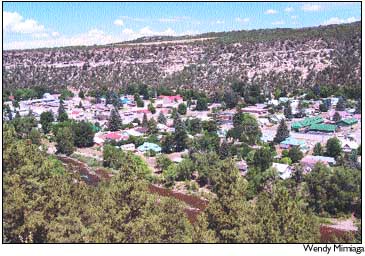|
July 12, 2001
By Jim Mimiaga Montezuma County officials were hesitant Monday to agree with a draft growth-management agreement for the county and the town of Dolores, saying it needed clarification and was too complicated. Officials with the town of Dolores came before the commissioners to discuss developing an intergovernmental agreement to better manage growth outside the town limits. The preliminary proposal for an urban-services zone calls for increased development regulations for new residences, including those on three-acre lots near town limits. But county administrator Tom Weaver warned that the proposal would impose stricter regulations than the county land-use code, which allows homes to be built on a three-acre minimum lot with an individual septic system. (Open lagoon systems are banned.) However, adopting a requirement that development on less than three acres be connected to a municipality’s sanitation lines is reasonable, and then an urban-services zone is more appropriate, county officials said. "Access to sewer lines needs to dictate high density growth and these urban-services zones, not how close a property is to town," Weaver said. "Otherwise you risk penalizing a landowner in the county because he lives near a town border." But without commitment from the Dolores Town Board on extending sewer and water lines upriver, where most of the growth is occurring, the commission said there could be no county urban-services zone specific to Dolores. "There is no point to an IGA without developer access to the town’s sanitation system. That process was for some reason stalled and needs to be put in place by Dolores before we can consider going forward with this urban-services zone," said Commissioner Gene Story. Dolores planning commissioners Marianne Mate and Rob Peterka discussed the most feasible growth zones around the town limits of Dolores, population 850. Granath Mesa on the north, Haycamp Mesa on the south and three miles upriver were cited as possible areas for future annexation. Growth is limited by steep valley walls and narrow access in and out of town. "But really the only practical growth is going to be upriver because getting water and sewer lines up the cliff sides is too expensive," said Peterka, Dolores planning chairperson. They presented the following preliminary urban-services-zone criteria for the commission to review: • High-impact development within one mile of town limits and three miles upriver would fall under the urban-services zone restrictions. • The rules for those areas would coincide with Dolores’ master street plan and uniform building codes, including for building and street setbacks, structure, foundation, plumbing and electrical. • Development would fall into two categories, small-lot and large-lot. A quarter-acre up to three acres per parcel would be considered small-lot development and would be subject to higher standards (i.e., curbs and gutters, paved streets, and sidewalks) because of density impacts. Large-lot developments would be above three acres per parcel and have fewer restrictions (gravel roads, no curbs, gutters or sidewalks required.) • The Dolores Town Ridgeline Ordinance would be extended to a one-mile buffer zone around town limits. The ordinance prevents building on the rocky, unstable cliff sides in town for safety and aesthetic reasons, but the ridge extends significantly beyond town boundaries and if developed could visually mar the character of the town. At a previous meeting with Dolores officials, the commissioners said they would be more comfortable accepting the ridgeline building restriction in a county/Dolores urban-services zone if the landowners involved were agreeable. This spring, Dolores planners sent letters to some 40 landowners with property on the ridgeline informing them of the ordinance and requesting a response if there was a problem. Mate said that they received two positive comments about the ordinance and no negative responses. • High-density, small-lot subdivisions be required to put up 8 percent of the land for dedicated open space or parks, or provide cash in lieu of the land, which would be put into Dolores park coffers. The planning conundrum is the same faced by all towns and the counties they sit in: how to match growth rules between two separate governments fairly, in a way that promotes conformity and future annexation while minimizing impacts. Not an easy job, but it becomes more difficult, Weaver said, when "the agreement is loaded up with so much stuff that no one can understand it." He said it took three years for an IGA of sorts to be finalized between Cortez and the county. Mancos has none. The stalemate in Cortez was broken after "we kept it simple by implementing only what we could agree on." That agreement requires projects near Cortez with plans for more than one house per three acres to match up with Cortez master street plan and building codes and have direct lines connecting to the Cortez Sanitation District sewer system. Peterka and Mate said that, while unlikely, a large, three-acre-lot development on Granath Mesa would greatly affect Dolores infrastructure and could warrant stricter regulations defined in an IGA between Dolores and the county. "They would be using Dolores as a hub as far as the roads, services, parks — so the town should be involved in that planning to minimize or mitigate the impacts," Peterka said, adding that any large subdivision, regardless of parcel size, has impacts and needs to be managed with future annexation in mind. Story noted that under the county review process, Dolores citizens and government would have an opportunity to air concerns regarding major developments proposed near Dolores. Planners speculated that without the town board’s commitment to extended sanitation lines, the IGA may boil down to a county building restriction on the Dolores ridgeline within one mile of town limits. |
||
|
Copyright © 2001 the Cortez Journal.
All rights reserved. |
